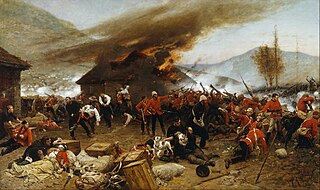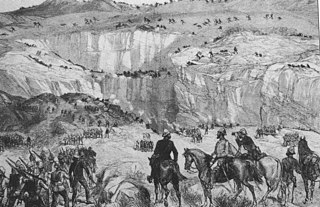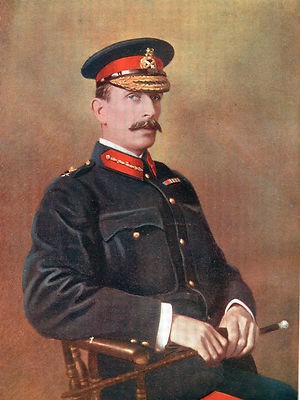
The Battle of Rorke's Drift, also known as the Defence of Rorke's Drift, was an engagement in the Anglo-Zulu War. The successful British defence of the mission station of Rorke's Drift, under the command of Lieutenants John Chard of the Royal Engineers and Gonville Bromhead, of the 24th Regiment of Foot, began once a large contingent of Zulu warriors broke off from the main force during the final hour of the British defeat at the day-long Battle of Isandlwana on 22 January 1879. They travelled 6 miles (9.7 km) to attack Rorke's Drift later that day and continuing into the following day.

The Anglo-Zulu War was fought in present-day South Africa from January to early July 1879 between forces of the British Empire and the Zulu Kingdom. Two famous battles of the war were the Zulu victory at Isandlwana and the British defence at Rorke's Drift.

The Battle of Isandlwana on 22 January 1879 was the first major encounter in the Anglo-Zulu War between the British Empire and the Zulu Kingdom. Eleven days after the British invaded Zululand in Southern Africa, a Zulu force of some 20,000 warriors attacked a portion of the British main column consisting of approximately 1,800 British, colonial and native troops with approximately 350 civilians. The Zulus were equipped mainly with the traditional assegai iron spears and cow-hide shields, but also had a number of muskets and antiquated rifles.

Zibhebhu kaMaphitha Zulu was a Zulu chief. After the defeat of the Zulu Kingdom by the British, he attempted to create his own independent kingdom. From 1883 to 1884, he fought the Zulu king Cetshwayo, inflicting a series of defeats on him.

General Sir Redvers Henry Buller, was a British Army officer and a recipient of the Victoria Cross, the highest award for gallantry awarded to British and Commonwealth forces. He served as Commander-in-Chief of British Forces in South Africa during the early months of the Second Boer War and subsequently commanded the army in Natal until his return to England in November 1900.

The Battle of Kambula took place on 29 March 1879, during the Anglo-Zulu War, when a Zulu military force attacked the British camp at Kambula, having routed the mounted element of the British force at the Battle of Hlobane the day before. The battle was a decisive Zulu defeat and the Zulu warriors lost their belief in victory. The war ended after the Zulu defeat at the Battle of Ulundi on 4 July 1879.

The Battle of Hlobane took place at Hlobane, near the modern town of Vryheid in KwaZulu-Natal, South Africa during the Anglo-Zulu War.

The SecondBattle of Colenso, also known as the Battle of Colenso, was the third and final battle fought during the Black Week of the Second Boer War. It was fought between British and Boer forces from the independent South African Republic and Orange Free State in and around Colenso, Natal, South Africa on 15 December 1899.

The Battle of Elandslaagte took place during the Second Boer War, and was one of the few clear-cut tactical victories won by the British during the conflict. However, the British force retreated afterwards, throwing away their advantage.

General Sir Baker Creed Russell was an Australian-born British Army officer who served with distinction in the Indian Mutiny, Anglo-Ashanti War, Anglo-Zulu War, Sekhukhune Wars, and Egyptian War

Sir Edward Robert Prevost Woodgate was an infantry officer in the British Army.

The Battle of Elands River took place near the Elands River Poort mountain pass on 17 September 1901 during the Second Boer War. During the battle a Boer raiding force under Jan Smuts destroyed a British cavalry squadron led by Captain Sandeman, a cousin of Winston Churchill, on the Modderfontein farm. This battle is therefore also known as the Battle of Modderfontein.

The Battle of Bakenlaagte in Eastern Transvaal, South Africa, occurred on 30 October 1901 during the guerrilla phase of Anglo-Boer war of 1899–1902. The battle saw the Eastern Transvaal Boer commandos of Generals Johan Grobler, Coen Brits, Piet Viljoen and Louis Botha attack the rearguard of Colonel Benson's much feared No. 3 Flying Column while it was in marching formation to its base camp. On the Boer side general Daniel Opperman was killed in the engagement. The Bakenlaagte battlefield is located on the Kriel-Kinross road at the intersection of the R547 and R580 roads in Mpumalanga Province, just south of Matla Power Station.
Princess Mkabayi kaJama was a Zulu princess, the head of the Qulusi military kraal, and a regent of the Zulu Kingdom. She persuaded her father, the Zulu King Jama kaNdaba, to remarry, and acted as a regent during the reign of her half-brother, Senzangakhona.

The 12 January 1879 action at Sihayo's Kraal was an early skirmish in the Anglo-Zulu War. The day after launching an invasion of Zululand, the British Lieutenant-General Lord Chelmsford led a reconnaissance in force against the kraal of Zulu Chief Sihayo kaXongo. This was intended to secure his left flank for an advance on the Zulu capital at Ulundi and as retribution against Sihayo for the incursion of his sons into the neighbouring British Colony of Natal.

Major General Ralph Arthur Penrhyn Clements,, commonly known as R. A. P. Clements, was a senior British Army officer.
The abaQulusi or Qulusi are a zulu tribe from South Africa. They are based in the abaqulusi district, Kwazulu-Natal, that bears their name.
Ian Knight is a British historian and writer, specialising in Anglo-Zulu and Boers wars.

The Zungwini Mountain skirmishes took place on 20, 22 and 24 January 1879 during the Anglo-Zulu War. The mountain was a stronghold of the AbaQulusi Zulu tribe, who were reinforced by the forces of exiled Swazi prince Mbilini waMswati. The mountain lay near the proposed route of advance of a British column under Lieutenant-Colonel Evelyn Wood, one of three that marched on the Zulu capital, Ulundi, from early January. Aware that the other columns had made less progress Wood, who had halted to fortify a camp at Tinta's Kraal, decided to deal with the abaQulusi strongholds.

The Battle of Silkaatsnek was a military engagement in the Anglo-Boer War on July 11, 1900, at the Silkaatsnek mountain pass, between Pretoria and Rustenburg. Boer guerrillas under assistant-commander general Koos de la Rey surprised British troops, using a new guerrilla tactic instead of fighting a set-piece battle. On the same day of July 11, 1900, the British also suffered two similar reversals, at Battle of Dwarsvlei in Krugersdorp district and at Onderstepoort, but a few days later, on 16 July 1900, they withstood a Boer attack in the Battle of Witpoort east of Pretoria.


















